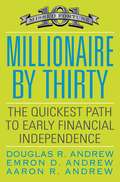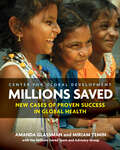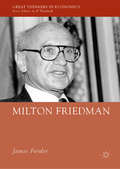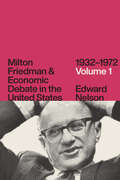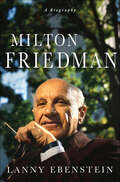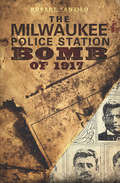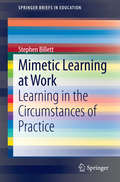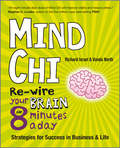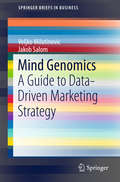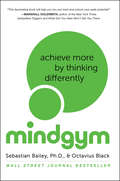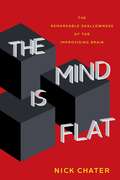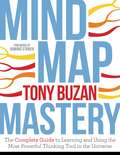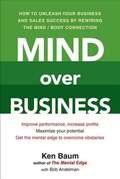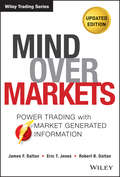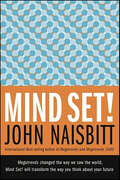- Table View
- List View
Millionaire Women Next Door: The Many Journeys of Successful American Businesswomen
by Thomas J. StanleyMillionaire Women Next Door explores the meaning of wealth and the avenues that female entrepreneurs and businesspeople have traveled. The book examines their choices, natures, working styles, and lifestyles.
Millionaire by Thirty: The Quickest Path to Early Financial Independence
by Douglas R. Andrew Emron Andrew Aaron AndrewMost people know that there are 70 million Baby Boomers in America today....but what is less known is that there are approximately 100 million people in America between the ages of 16 and 30. This generation has just entered, or will soon be entering the work force. And they have no idea how to invest, save, or handle their money. Young people today come out of school having had little or no formal education on the basics of money management. Many have large debts from student loans looming over their heads. And many feel confused and powerless when their pricey educations don't translate into high paying jobs. They feel that their $30,000-$40,000 salary is too meager to bother with investing, and they constantly fear that there will be "too much month left at the end of their money." Douglas R. Andrew has shown the parents of this generation a different pathway to financial freedom. Now Doug and his sons, Emron and Aaron - both of whom are in their mid-20s - show the under-30 crowd how they can break from traditional 401k investment plans and instead can find a better way by investing in real estate, budgeting effectively, avoiding unnecessary taxes and using life insurance to create tax-free income. With the principles outlined in Millionaire by Thirty, recent graduates will be earning enough interest on their savings to meet their basic living expenses by the time they're 30. And by the time they're 35, their investments will be earning more money than they are, guaranteeing them a happy, wealthy future.
Millionaire: The Philanderer, Gambler, and Duelist Who Invented Modern Finance
by Janet GleesonOn the death of France's most glorious king, Louis XIV, in 1715, few people benefited from the shift in power more than the intriguing financial genius from Edinburgh, John Law. Already notorious for killing a man in a duel and for acquiring a huge fortune from gambling, Law had proposed to the English monarch that a bank be established to issue paper money with the credit based on the value of land. But Queen Anne was not about to take advice from a gambler and felon. So, in exile in Paris, he convinced the bankrupt court of Louis XV of the value of his idea. Law soon engineered the revival of the French economy and found himself one of the most powerful men in Europe. In August 1717, he founded the Mississippi Company, and the Court granted him the right to trade in France's vast territory in America. The shareholders in his new trading company made such enormous profits that the term "millionaire" was coined to describe them. Paris was soon in a frenzy of speculation, conspiracies, and insatiable consumption. Before this first boom-and-bust cycle was complete, markets throughout Europe crashed, the mob began calling for Law's head, and his visionary ideas about what money could do were abandoned and forgotten. In Millionaire, Janet Gleeson lucidly reconstructs this epic drama where fortunes were made and lost, paupers grew rich, and lords fell into penury -- and a modern fiscal philosophy was born. Her enthralling tragicomic tale reveals two great characters: John Law, with his complex personality and inscrutable motives, and money itself, whose true nature even to this day remains elusive.
Millionnaire en un clic
by Henry Osal Gouzée MarjorieMillionaire en un clic est un petit guide pour les débutants qui souhaitent gagner de l'argent via Internet. Il est aujourd'hui possible de gagner de l'argent en ligne grâce à des dizaines de méthodes et ressources. L'auteur, un coach et expert en marketing en ligne qui a aidé des dizaines d'entreprises et de particuliers à réussir sur la toile, a sélectionné les méthodes les plus appropriées et fiables. Des explications simples accompagnent chaque technique. Certaines vous permettront d'obtenir des revenus modestes rapidement, d'autres sont plus ambitieuses mais nécessitent dès lors plus d'efforts pour porter leurs fruits. Toutes ont été testées directement par l'auteur, et sont sérieuses et efficaces. Si vous désirez, en ces temps de crise, trouver une nouvelle manière passionnante de générer des revenus, Millionnaire en un clic est fait pour vous.
Millions Saved: New Cases of Proven Success in Global Health
by Amanda Glassman Miriam TeminOver the past fifteen years, people in low- and middle-income countries have experienced a health revolution-one that has created new opportunities and brought new challenges. It is a revolution that keeps mothers and babies alive, helps children grow, and enables adults to thrive. Millions Saved: New Cases of Proven Success in Global Health chronicles the global health revolution from the ground up, showcasing twenty-two local, national, and regional health programs that have been part of this global change. The book profiles eighteen remarkable cases in which large-scale efforts to improve health in low- and middle-income countries succeeded, and four examples of promising interventions that fell short of their health targets when scaled-up in real world conditions. Each case demonstrates how much effort-and sometimes luck-is required to fight illness and sustain good health.The cases are grouped into four main categories, reflecting the diversity of strategies to improve population health in low-and middle-income countries: rolling out medicines and technologies; expanding access to health services; targeting cash transfers to improve health; and promoting population-wide behavior change to decrease risk. The programs covered also come from various regions around the world: seven from sub-Saharan Africa, six from Latin America and the Caribbean, five from East and Southeast Asia, and four from South Asia.
Milton Friedman (Great Thinkers in Economics)
by James ForderThis book examines the work of Milton Friedman, which is amongst the most significant in modern economics and, equally, amongst the most contentious. Although Friedman became most famous for his views on money and monetary policy as well as his public writings, a large and important part of his work concerned other aspects of economics.All parts of Friedman’s work are considered here, as is his account of his own life. By focussing on what Friedman wrote rather than what later authors have written about him, this volume seeks to analyse the character, qualities and development of the arguments he made. This text is important for anyone interested in this both celebrated and reviled figure in economics. James Forder clarifies messages in Friedman’s writing that have otherwise so often been obscured by academic and public controversy.
Milton Friedman and Economic Debate in the United States, 1932–1972, Volume 1 (Milton Friedman & Economic Debate in the United States)
by Edward NelsonMilton Friedman is widely recognized as one of the most influential economists of the twentieth century. Yet no previous study has distilled Friedman’s vast body of writings into an authoritative account of his research, his policy views, and his interventions in public debate. With this ambitious new work, Edward Nelson closes the gap: Milton Friedman and Economic Debate in the United States is the defining narrative on the famed economist, the first to grapple comprehensively with Friedman’s research output, economic framework, and legacy. This two-volume account provides a foundational introduction to Friedman’s role in several major economic debates that took place in the United States between 1932 and 1972. The first volume, which takes the story through 1960, covers the period in which Friedman began and developed his research on monetary policy. It traces Friedman’s thinking from his professional beginnings in the 1930s as a combative young microeconomist, to his wartime years on the staff of the US Treasury, and his emergence in the postwar period as a leading proponent of monetary policy. The second volume covers the years between 1960 and 1972— years that saw the publication of Friedman and Anna Schwartz’s Monetary History of the United States. The book also covers Friedman’s involvement in a number of debates in the 1960s and 1970s, on topics such as unemployment, inflation, consumer protection, and the environment. As a fellow monetary economist, Nelson writes from a unique vantage point, drawing on both his own expertise in monetary analysis and his deep familiarity with Friedman’s writings. Using extensive documentation, the book weaves together Friedman’s research contributions and his engagement in public debate, providing an unparalleled analysis of Friedman’s views on the economic developments of his day.
Milton Friedman: A Biography
by Lanny EbensteinThe first biography of one of the twentieth century's greatest economic thinkers, Milton Friedman.Born the son of immigrant parents, Milton Friedman went on to become a major figure during the resurgence of American conservatism. As an advisor to the Reagan administration and a widely read columnist, he played a vital role in shaping government policy and public opinion while he made headlines for his controversial views.Drawing on author Lanny Ebenstein's unprecedented access to personal archives and to Friedman himself, this is the first book to trace his life and development as an economic theorist. With a combination of intimate personal detail and fascinating exploration of economic theory, Milton Friedman: A Biography provides a revealing look at the man regarded by many as a hero of libertarianism and laissez-faire economics.
Milton Friedman: The Last Conservative
by Jennifer BurnsAn Economist Best Book of 2023 | One of The New York Times’ 33 Nonfiction Books to Read This Fall | Named a most anticipated fall book by the Chicago Tribune and Bloomberg | Finalist for the 2024 Hayek Book Prize“Wherever you sit on the political spectrum, there’s a lot to learn from this book. More than a biography of one controversial person, it’s an intellectual history of twentieth-century economic thought.” —Greg Rosalesky, NPR’s Planet Money The first full biography of America’s most renowned economist.Milton Friedman was, alongside John Maynard Keynes, the most influential economist of the twentieth century. His work was instrumental in the turn toward free markets that defined the 1980s, and his full-throated defenses of capitalism and freedom resonated with audiences around the world. It’s no wonder the last decades of the twentieth century have been called “the Age of Friedman”—or that analysts have sought to hold him responsible for both the rising prosperity and the social ills of recent times.In Milton Friedman, the first full biography to employ archival sources, the historian Jennifer Burns tells Friedman’s extraordinary story with the nuance it deserves. She provides lucid and lively context for his groundbreaking work on everything from why dentists earn less than doctors, to the vital importance of the money supply, to inflation and the limits of government planning and stimulus. She traces Friedman’s long-standing collaborations with women, including the economist Anna Schwartz; his complex relationships with powerful figures such as the Federal Reserve chairman Arthur Burns and the Treasury secretary George Shultz; and his direct interventions in policymaking at the highest levels. Most of all, Burns explores Friedman’s key role in creating a new economic vision and a modern American conservatism. The result is a revelatory biography of America’s first neoliberal—and perhaps its last great conservative.
Milton Glaser: Graphic Design
by Milton GlaserThis essential volume by the godfather of modern graphic design explores his process and showcases his highly influential early-career work. This gorgeously illustrated volume delves into the early decades of America’s pre-eminent graphic artist. Milton Glaser’s work ranges from the iconic I Love New York logo to the famous psychedelic Bob Dylan poster and numerous book and record covers; it encompasses everything from store and restaurant design to toy creations as well as magazine formats and logotypes, including New York magazine. In short, his work has helped define the look of our time.Here Glaser undertakes a remarkably wide-ranging representation of his oeuvre. In a new introduction, he speaks of the influences on his work, the responsibilities of the artist, the hierarchies of the traditional art world, and the role of graphic design in the area of his creative growth. First published in 1973, Milton Glaser: Graphic Design is an extraordinary achievement and an indisputable classic.
Milton Hershey
by Jane SutcliffeNearly everyone knows the name Hershey. That's because Milton Hershey put his name on one of the most delicious foods in the world-chocolate. In the early 1900s, he invented a new recipe for milk chocolate. His five cent chocolate bars because a big business. But Milton Hershey wasn't always successful. The first few times he tried to sell candy, he failed. Still, Milton would not give up. He worked hard to invent delicious new recipes. He kept trying until his candy made him a wealthy man. Then he surprised everyone by give his money away.
Milton Hershey: More Than Chocolate (Heroes of History)
by Janet Benge Geoff Benge'We've done more than our share to see you right, but you're a Hershey, a true son of a dreamer,' Milton's Uncle Abraham said. 'You'll never stick with anything long enough to make it work for you.' Milton gulped. He'd already suspected that his relatives had given up on him succeeding as a candy maker, but the words still stung. <p><p> When Milton Hershey's famous Hershey Bars debuted in 1905, few people knew of the hard work, dedication, and sacrifice preceding the triumph. Debt, lack of support, and fatigue had been constant companions for the famous chocolatier and philanthropist -- a man with a fourth-grade education. <p><p> Despite comparisons to his wandering father, Milton never gave up. Learning from his mistakes, he spent a lifetime creating sweet things to eat -- first caramel, then chocolate. As his company soared, Milton used his wealth to care for others, founding a town for Hershey workers, a school for children in need, and a foundation dedicated to education, culture, and health care.
Milwaukee Police Station Bomb of 1917, The (True Crime)
by Robert TanziloOn a chilly day in September, the patriotic, pro-Protestant preaching of an Italian immigrant pastor, August Giuliani, ignited a riot in Milwaukee's small Italian enclave of Bay View that injured two policemen and killed two rioters. Two months later, someone placed a bomb in Giuliani's Third Ward church in an apparent act of retaliation, and a parishioner carried the explosive to Central Police Station, where it detonated, killing nine policemen and a civilian. Within a week, the trial of the Bay View Italians began in a city inflamed with fear, distrust and vengeance. The national buzz attracted big names to the case, including attorney Clarence Darrow and radical heroine Emma Goldman. Join Robert Tanzilo as he carefully navigates the minefield of racial, political and religious tension that tore apart Milwaukee's Italian community in 1917.
Mimetic Learning at Work
by Stephen BillettThe concept of mimetic learning at work is outlined and elaborated in this text. That elaboration consists of an account of how securing occupational capacities has been primary associated with learning processes and an explanation of those processes. Much, and probably most, of the learning and development across individuals working lives occurs outside of circumstances of direct guidance or instruction. Yet, recent considerations of individuals' epistemologies and developments form anthropology and cognitive science suggest that current explanations about individuals' contributions to learning at and through work are incomplete. So, there is need for an emphasis on individuals' processes of learning, both within and outside of situations of guidance by more experienced workers, needs to be more fully understood, and accepted as being person dependent. Contributions from anthropology, developmental studies, and cognitive neuroscience now augment those from sociocultural theory.
Mina O'Reilly at Logan Airport's TSA
by Michel Anteby Erin McfeeMina O'Reilly, an officer at Logan Airport's Transportation Security Administration (TSA) in Boston, must discipline an employee responsible for a security breach that resulted in a 45-minute terminal closure during peak hours, a potential threat to traveler safety, and travel delays across the U.S. O'Reilly considers the impact of her decision on a shifting labor force: the growing divide between those employees deeply committed to the mission and those joining to simply find a job. The senior TSA staff and airlines are calling for accountability, but the person responsible for the breach is a passionate and valued employee who has been with TSA since its formation. As her shift approaches, O'Reilly must decide whether or not she can clock in as usual.
Mind Chi: Re-wire Your Brain in 8 Minutes a Day -- Strategies for Success in Business and Life
by Richard Israel Vanda North8 minutes a day is all it takes to open up a world of superior mental performance. Just as Tai Chi has been used for centuries to balance body and mind, Mind Chi will help you increase your mental energy and be more effective in everything you do. And all you need is 8 minutes a day... Mind Chi is a powerful synthesis of thought and action based on the most recent research into how the brain works. By following the simple, daily exercises in this book, you will raise your mental performance to a level you never thought possible. Discover: Sharper powers of concentration and information management Improved control over your attention span, memory, thoughts and feelings Fast and easy ways to reduce your stress and increase your confidence New positive habits, thoughts and mental resilience Fantastic energy levels, during and after your work day Plus: 50 Strategies for Success in Business & Life "An eight minute daily dose of Mind Chi will improve vitality, reduce stress and allow us to see the many blessings of life more clearly." --Stephen C. Lundin PhD, author of the five million copy bestselling FISH!
Mind Games: Inspirational Lessons from the World's Finest Sports Stars
by Jeff Grout Sarah Perrin Sir Clive WoodwardWhat makes a winner - in business or in sport? Why do some people consistently break sales targets, cross the line first or hammer the ball in the net with pinpoint accuracy? Natural talent and disciplined training are vital. But with two equally matched professionals, something else makes the difference that provides that extra, champion factor: the mind. Mind Games looks into the mental processes of sporting stars, identifying the attitudes and approaches that enable them to achieve peak performance, every time, and applies them specifically to the world of business. What are the key mental characteristics that make some people come out on top? How do winners channel adrenalin into controlled power while losers choke? What do sportsmen and women mean when they talk about 'the inner game', being 'in the zone' or being 'in the now'? What is it that coaches do to realise the potential they see? What are the lessons that business winners need to learn from sport's superstars? Mind Games has the full involvement of over 30 sporting household names, including Sven-Goran Eriksson, Matthew Pinsent, Clive Woodward, Nick Faldo, Jonny Wilkinson. The authors draw on extensive first-hand experiences of acknowledged sporting champions across a range of sports, identifying personal techniques proven to have worked under the pressure of top-level competition. They also draw on the expertise of professional coaches and psychologists who have worked with sportsmen and women.
Mind Genomics
by Jakob Salom Veljko MilutinovicIn this book, the authors describe how Mind Genomics works - a revolutionary marketing method that combines the three sciences of Mathematics, Psychology, and Economics - in a masterful way. Mind Genomics helps the seller of products and services to know what people are thinking about them before one ever commits to an approach by knowing what is important to the people one is trying to influence. Mind Genomics identifies what aspects of a general topic are important to the audience, how different people in the audience will respond to different aspects of that topic, and how to pinpoint the viewpoints of different audience segments to each aspect of the topic. A careful step by step approach explains what activities ought to be taken and what scenarios must be followed while applying this method in order to find the right way to capture the hearts and minds of targeted audiences. This book explains how Mind Genomics plays a matching game with one's potential audience and various ways one can present the products and ideas resulting in a systematic approach to influencing others, backed by real data; how one can play with ideas, see patterns imposed by the mind and create new, inductive, applied sciences of the mind, measuring the world using the mind of man as the yardstick. In details it describes how everyday thought is transferred into actionable data and results. Whether one is a senior marketer for a large corporation, a professor at a university, or administrator at a hospital, one could use Mind Genomics to learn how to transform available information into actionable steps that will increase the products sales, or increase the number of interested students for a new university program, or the number of satisfied patients in the hospital with their medical conditions kept at highest levels after leaving it. Mind Genomics was first introduced by Dr. Howard Moskowitz, an alumnus of Harvard University and the father of Horizontal Segmentation - a widely accepted business model for targeted marketing and profit maximization.
Mind Gym
by Sebastian Bailey Octavius BlackTransform Your Personal and Work Life by Changing the Way You ThinkRunning out of time? Feeling misunderstood? Stuck in a rut? Do you feel like you are not getting enough of what you truly want? You are not alone. The pressure to succeed at work and in our personal lives is stronger today than ever.Sebastian Bailey and Octavius Black believe that to thrive in our busy world, your mind needs to work at its full potential. But unless you train it, your mind stays on autopilot, stuck in unhealthy thought patterns that lead to self-sabotaging habits and behaviors--like unwittingly talking in ways that damage your relationships or working in unproductive ways. Just as you exercise your body to stay in shape, you have to exercise your mind to get the most out of it.Motivated to help people change their mental default settings, Bailey and Black cofounded Mind Gym, the world's fastest-growing human performance business. Since then, Mind Gym has changed the way over one million people choose to think through mental workouts delivered at companies such as Google, Microsoft, BuzzFeed, MetLife, and PepsiCo. In this hands-on book, Bailey and Black present the best of these workouts, helping you tackle the most common challenges at work and home: How to win people around to your point of view How to repair broken relationships How to get more done and have spare time How to adopt a positive mindset How to solve problems that once seemed intractable How to be less stressed and have more energyBrimming with insight, proven to work, and immensely practical, Mind Gym is the essential fitness program of the mind that will help you be your best every day and manifest your highest potential.
Mind Into Matter
by Udayan GuptaMIND INTO MATTERSince 1980, when the United States government first allowed universities and laboratories to reap commercial profits from federally-funded projects, top institutions have been licensing their research. Over the past decade, more and more institutions believe the big money is in commercializing the research themselves. To create sustainable technology transfer programs, universities must risk their own capital. In doing so, they find themselves having to set up virtual venture-capital funds - often with sorry results. Yet, technology transfer has had considerable success and continues to hold great promise for universities, scientists, and venture capitalists. What are the approaches and elements involved in bridging the gap between academic research and entrepreneurial commercial success? Mind into Matter explores the hiostory and issues of transferring ideas from university researchlabs to the marketplace, and the commercial and global benefits of this process.
Mind Is Flat: The Remarkable Shallowness of the Improvising Brain
by Nick ChaterIn a radical reinterpretation of how the mind works, an eminent behavioral scientist reveals the illusion of mental depth Psychologists and neuroscientists struggle with how best to interpret human motivation and decision making. The assumption is that below a mental “surface” of conscious awareness lies a deep and complex set of inner beliefs, values, and desires that govern our thoughts, ideas, and actions, and that to know this depth is to know ourselves. In this profoundly original book, behavioral scientist Nick Chater contends just the opposite: rather than being the plaything of unconscious currents, the brain generates behaviors in the moment based entirely on our past experiences. Engaging the reader with eye-opening experiments and visual examples, the author first demolishes our intuitive sense of how our mind works, then argues for a positive interpretation of the brain as a ceaseless and creative improviser.
Mind Map Mastery: The Complete Guide To Learning And Using The Most Powerful Thinking Tool In The Universe
by Tony BuzanFor the past five decades, Tony Buzan has been at the leading edge of learning and educational research with his revolutionary Mind Map technique. With Mind Map Mastery, he has distilled these years of global research into the clearest and most powerful instructional work available on the Mind Map technique.Tony Buzan invented the Mind Map technique five decades ago. Seeing the transformational impact it had on people, he has been spreading the thinking tool across the world ever since.Tony Buzan's Mind Map technique has gathered amazing praise and an enormous worldwide following over the last few decades, but as with any very successful idea, there have been many sub-standard imitators. With Mind Map Mastery, Tony Buzan re-establishes the essential concepts that are the core of the Mind Map with a clarity and practicality unrivalled by other books.If you are looking to improve your memory, plan your business strategy, become more organized, study for an exam or plan out your future, this is the book for you. With a clarity and depth that far exceeds any other book on the subject, it includes the history of the development of the Mind Map, an explanation of what makes a Mind Map (and what isn't a Mind Map) and why it's such a powerful tool, illustrated step-by-step techniques for Mind Map development – from simple to complex applications – and how to deal with Mind Maps that have “gone wrong”. Developed both for those new to the Mind Map concept as well as more experienced users who would like to revise and expand their expertise, Mind Map Mastery is the one Mind Mapping book needed on the shelf of every student and business person across the world.
Mind Over Business: How to Unleash Your Business and Sales Success by Rewiring the Mind/Body Connection
by Bob Andelman Ken BaumImagine making a few small adjustments to your workday to discover latent talents you didn't know you had. In Mind Over Business, sports psychologist Ken Baum applies a proven system for peak performance that will help you reach your goals no matter what business you are in. Every day, Baum earns his living by guiding people to maximize their career and potential. Now he translates his unique knowledge and techniques into a program you can use to thrive in every aspect of your career. Mind Over Business will give you the mental edge to overcome obstacles and take advantage of opportunity. It prescribes exercises that go beyond motivation to create a road map for success. You'll learn how to create a Personal Action Plan that outlines your goals logically and concretely, followed by a Reward Statement and Desire Statement that fuel your drive every step of the way. Simple visualization and performance cue exercises will keep you on target no matter what obstacles get in your way. Mind Over Business gives you the tools you need to change your brain and improve your career. It doesn't matter if you're self- employed, work for a large company, or sell insurance or sandwiches. You'll learn to beat your competition regardless of your background or business. .
Mind Over Markets
by James F. Dalton Robert B. Dalton Eric T. JonesA timely update to the book on using the Market Profile method to trade Emerging over twenty years ago, Market Profile analysis continues to realize a strong following among active traders. The approach explains the underlying dynamics and structure of markets, identifies value areas, price rejection points, and measures the strength of buyers and sellers. Unlike more conventional forms of technical analysis, Market Profile is an all-encompassing approach, and Mind Over Markets, Updated Edition provides traders with a solid understanding of it.Since the first edition of Mind Over Markets--considered the best book on applying Market Profile analysis to trading--was published over a decade ago, much has changed in the worlds of finance and investing. That's why James Dalton, a pioneer in the popularization of Market Profile, has returned with a new edition of this essential guide. Written to reflect today's dynamic market conditions, Mind Over Markets, Updated Edition clearly puts this unique method of interpreting market behavior and identifying trading/investment opportunities in perspective.Includes new chapters on Market Profile-based trading strategies, using Market Profile in connection with other market indicators, and much moreExplains how the Market Profile approach has evolved over the past twenty-five years and how it is used by contemporary tradersWritten by a leading educator and authority on the Market ProfileOne of the key elements that has long separated successful traders from the rest is their intuitive understanding that time regulates all financial opportunities. The ability to record price information according to time has unleashed huge amounts of useful market information. Mind Over Markets, Updated Edition will show you how to profitably put this information to work for you.
Mind Set!: Eleven Ways to Change the Way You See—and Create—the Future
by John NaisbittIn his seminal works Megatrends and Megatrends 2000, John Naisbitt proved himself one of the most far-sighted and accurate observers of our fast-changing world. Mind Set! goes beyond that by disclosing the secret of forecasting. Naisbitt gives away the keys to the kingdom, opening the door to the insights that let him understand today's world and see the opportunities of tomorrow. He selects his most effective tools, 11 Mindsets, and applies them by guiding the reader through the five forces that will dominate the next decades of the twenty-first century. Illustrated by stories about Galileo and Einstein to today's icons and rebels in business, science, and sports, Mind Set! opens your eyes to see beyond media headlines, political slogans, and personal opinions to select and judge what will form the pictures of the future.

